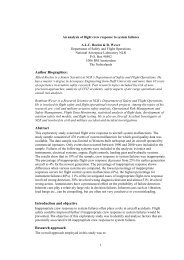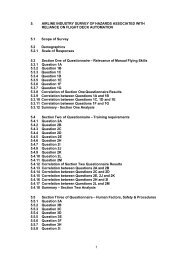Causal risk models of air transport - NLR-ATSI
Causal risk models of air transport - NLR-ATSI
Causal risk models of air transport - NLR-ATSI
You also want an ePaper? Increase the reach of your titles
YUMPU automatically turns print PDFs into web optimized ePapers that Google loves.
ticket sales (relative to pre-accident)<br />
100<br />
90<br />
80<br />
70<br />
60<br />
50<br />
40<br />
30<br />
20<br />
10<br />
0<br />
-2 -1 0 1 2 3 4 5 6 7 8<br />
Weeks since accident<br />
Figure 8: Estimated changes in new DC-10 bookings on competitive routes after 1989<br />
Sioux City DC-10 crash (relative to pre-crash levels). Source: Barnett et al [1992].<br />
4.2. Who are the users?<br />
According to the Dutch Ministry <strong>of</strong> Transport, the potential users <strong>of</strong> a causal <strong>risk</strong> model are<br />
<strong>air</strong>lines, <strong>air</strong> navigation service providers, <strong>air</strong>port organisations, maintenance and rep<strong>air</strong><br />
organisations, <strong>air</strong>craft manufactures, the central government and the aviation inspectorate.<br />
The projected use is not limited to the Netherlands, so the ‘central government’ could also<br />
mean other national governments, the European Commission, or ICAO. However, when<br />
some <strong>of</strong> these organisations were asked directly, many doubted whether a causal <strong>risk</strong> model<br />
could be useful for them. Especially the industry had difficulty to imagine how a causal <strong>risk</strong><br />
model could support them in taking daily decisions. The model was nevertheless not<br />
rejected a priori as useless, the opinion was rather that ‘when the causal <strong>risk</strong> model is ready<br />
we will see what we can do with it’ [De Jong 2006]. In this thesis, we will thus consider<br />
each <strong>of</strong> the above mentioned organisations as a potential user <strong>of</strong> a causal <strong>risk</strong> model.<br />
4.3. Perspectives on aviation safety<br />
This section describes the different perspectives that the stakeholders in the aviation system<br />
may have with respect to aviation safety and how this influences their opinion on the need<br />
to manage and improve safety. A description <strong>of</strong> the possible role <strong>of</strong> a causal <strong>risk</strong> model is<br />
given for every stakeholder based on their needs.<br />
4.3.1. Airlines<br />
For <strong>air</strong>line management, meeting the minimum safety standards set by the aviation<br />
authorities is a necessary requirement for obtaining an Air Operator Certificate (AOC). In<br />
addition to that, <strong>air</strong>line management will be aware <strong>of</strong> the fact that suffering a major<br />
accident may result in significant costs due to decreased ticket sales and may even cause an<br />
<strong>air</strong>line to go bankrupt, even though most <strong>air</strong>lines have adequate insurance to meet virtually<br />
all the direct costs arising from an accident (see infobox on the role <strong>of</strong> insurance).<br />
Especially very small <strong>air</strong>lines in the holiday charter business are vulnerable in this respect,<br />
because they are <strong>of</strong>ten not able to survive the immediate loss <strong>of</strong> income that is the result <strong>of</strong><br />
one <strong>of</strong> their <strong>air</strong>craft being no longer available and <strong>of</strong> the effect <strong>of</strong> the crash on public<br />
perception. However, accidents can impact the business <strong>of</strong> larger <strong>air</strong>lines as well. Examples<br />
43




